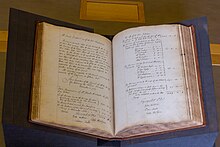This article includes a list of general references, but it lacks sufficient corresponding inline citations. (October 2020) |
William Brouncker, 2nd Viscount Brouncker FRS (c. 1620 – 5 April 1684) was an Anglo-Irish peer and mathematician who served as the president of the Royal Society from 1662 to 1677. Best known for introducing Brouncker's formula, he also worked as a civil servant, serving as a commissioner in the Royal Navy. Brouncker was a friend and colleague of Samuel Pepys, and features prominently in the Pepys' diary.
The Viscount Brouncker | |
|---|---|
 | |
| President of the Royal Society | |
| In office 1662–1677 | |
| Preceded by | Office established |
| Succeeded by | Joseph Williamson |
| Personal details | |
| Born | c. 1620 Castlelyons, Ireland |
| Died | 5 April 1684 (aged 64) Westminster, London |
| Residence | England |
| Alma mater | University of Oxford |
| Known for | Brouncker's formula, leadership of Royal Society |
| Scientific career | |
| Fields | Mathematician, civil servant |
| Institutions | Saint Catherine's Hospital |
| Academic advisors | John Wallis |

Biography
editBrouncker was born c. 1620 in Castlelyons, County Cork, the elder son of William Brouncker (1585–1649), 1st Viscount Brouncker and Winifred, daughter of Sir William Leigh of Newnham. His family came originally from Melksham in Wiltshire. His grandfather Sir Henry Brouncker (died 1607) had been Lord President of Munster 1603–1607, and settled his family in Ireland. His father was created a viscount in the Peerage of Ireland in 1645 for his services to the Crown. Although the first viscount had fought for the Crown in the Anglo-Scots war of 1639, malicious gossip said that he paid the then enormous sum of £1200 for the title and was almost ruined as a result. He died only a few months afterwards.
William obtained a DM at the University of Oxford in 1647. Until 1660 he played no part in public life: being a staunch Royalist, he felt it best to live quietly and devote himself to his mathematical studies. He was one of the founders and the first president of the Royal Society. In 1662, he became chancellor to Queen Catherine, then head of the Saint Catherine's Hospital. He was appointed one of the commissioners of the Royal Navy in 1664, and his career thereafter can be traced in the Diary of Samuel Pepys; despite their frequent disagreements, Samuel Pepys on the whole respected Brouncker more than most of his other colleagues, writing in 1668 that "in truth he is the best of them".
Although his attendance at the Royal Society had become infrequent, and he had quarrelled with some of his fellow members, he was nonetheless greatly displeased to be deprived of the presidency in 1677. He was commissioner for executing the office of Lord High Admiral of England from 1679.[1]
Abigail Williams
editBrouncker never married, but lived for many years with the actress Abigail Williams (much to Pepys' disgust) and left most of his property to her. She was the daughter of Sir Henry Clere (died 1622), first and last of the Clere Baronets, and the estranged wife of John Williams, otherwise Cromwell, second son of Sir Oliver Cromwell, and first cousin to the renowned Oliver Cromwell. She and John had a son and a daughter. The fire of 1673 which destroyed the Royal Navy Office started in her private closet: this is unlikely to have improved her relations with Samuel Pepys, whose private apartments were also destroyed in the blaze.
On Brouncker's death in 1684, his title passed to his brother Henry, one of the most detested men of the era. William left him almost nothing in his will "for reasons I think not fit to mention".
Mathematical works
editHis mathematical work concerned in particular the calculations of the lengths of the parabola and cycloid, and the quadrature of the hyperbola,[2] which requires approximation of the natural logarithm function by infinite series.[3] He was the first European to solve what is now known as Pell's equation. He was the first in England to take interest in generalized continued fractions and, following the work of John Wallis, he provided development in the generalized continued fraction of pi.
Brouncker's formula
editThis formula provides a development of π/4 in a generalized continued fraction:
The convergents are related to the Leibniz formula for pi: for instance
and
Because of its slow convergence, Brouncker's formula is not useful for practical computations of π.
Brouncker's formula can also be expressed as[4]
See also
editReferences
edit- ^ "No. 1485". The London Gazette. 9 February 1679. p. 2.
- ^ W. Brouncker (1667) The Squaring of the Hyperbola, Philosophical Transactions of the Royal Society of London, abridged edition 1809, v. i, pp 233–6, link form Biodiversity Heritage Library
- ^ Julian Coolidge Mathematics of Great Amateurs, chapter 11, pp. 136–46
- ^ John Wallis, Arithmetica Infinitorum, ... (Oxford, England: Leon Lichfield, 1656), page 182. Brouncker expressed, as a continued fraction, the ratio of the area of a circle to the area of the circumscribed square (i.e., 4/π). The continued fraction appears at the top of page 182 (roughly) as: ☐ = 1 1/2 9/2 25/2 49/2 81/2 &c , where the square denotes the ratio that is sought. (Note: On the preceding page, Wallis names Brouncker as: "Dom. Guliel. Vicecon, & Barone Brouncher" (Lord William Viscount and Baron Brouncker).)
External links
edit- O'Connor, John J.; Robertson, Edmund F., "William Brouncker, 2nd Viscount Brouncker", MacTutor History of Mathematics Archive, University of St Andrews
- . Dictionary of National Biography. London: Smith, Elder & Co. 1885–1900.